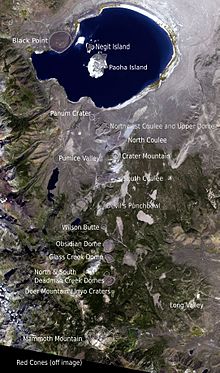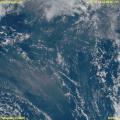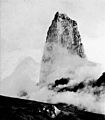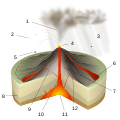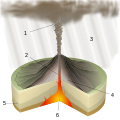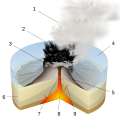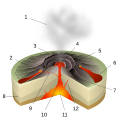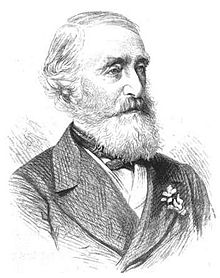Portal:Volcanoes
The Volcanoes portal
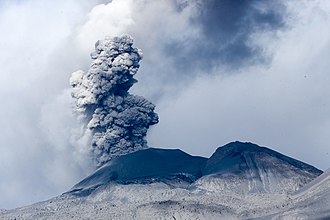
On Earth, volcanoes are most often found where tectonic plates are diverging or converging, and because most of Earth's plate boundaries are underwater, most volcanoes are found underwater. For example, a mid-ocean ridge, such as the Mid-Atlantic Ridge, has volcanoes caused by divergent tectonic plates whereas the Pacific Ring of Fire has volcanoes caused by convergent tectonic plates. Volcanoes can also form where there is stretching and thinning of the crust's plates, such as in the East African Rift and the Wells Gray-Clearwater volcanic field and Rio Grande rift in North America. Volcanism away from plate boundaries has been postulated to arise from upwelling diapirs from the core–mantle boundary, 3,000 kilometers (1,900 mi) deep within Earth. This results in hotspot volcanism, of which the Hawaiian hotspot is an example. Volcanoes are usually not created where two tectonic plates slide past one another.
Large eruptions can affect atmospheric temperature as ash and droplets of sulfuric acid obscure the Sun and cool Earth's troposphere. Historically, large volcanic eruptions have been followed by volcanic winters which have caused catastrophic famines.
Other planets besides Earth have volcanoes. For example, volcanoes are very numerous on Venus. In 2009, a paper was published suggesting a new definition for the word ‘volcano’ that includes processes such as cryovolcanism. It suggested that a volcano be defined as ‘an opening on a planet or moon’s surface from which magma, as defined for that body, and/or magmatic gas is erupted.’
This article mainly covers volcanoes on Earth. See § Volcanoes on other celestial bodies and Cryovolcano for more information. (Full article...)
Selected article -
The Mono–Inyo Craters are a volcanic chain of craters, domes and lava flows in Mono County, Eastern California. The chain stretches 25 miles (40 km) from the northwest shore of Mono Lake to the south of Mammoth Mountain. The Mono Lake Volcanic Field forms the northernmost part of the chain and consists of two volcanic islands in the lake and one cinder cone volcano on its northwest shore. Most of the Mono Craters, which make up the bulk of the northern part of the Mono–Inyo chain, are phreatic (steam explosion) volcanoes that have since been either plugged or over-topped by rhyolite domes and lava flows. The Inyo volcanic chain form much of the southern part of the chain and consist of phreatic explosion pits, and rhyolitic lava flows and domes. The southernmost part of the chain consists of fumaroles and explosion pits on Mammoth Mountain and a set of cinder cones south of the mountain; the latter are called the Red Cones.
Eruptions along the narrow fissure system under the chain began in the west moat of Long Valley Caldera 400,000 to 60,000 years ago. Mammoth Mountain was formed during this period. Multiple eruptions from 40,000 to 600 years ago created the Mono Craters and eruptions 5,000 to 500 years ago formed the Inyo volcanic chain. Lava flows 5,000 years ago built the Red Cones, and explosion pits on Mammoth Mountain were excavated in the last 1,000 years. Uplift of Paoha Island in Mono Lake about 250 years ago is the most recent activity. These eruptions most likely originated from small magma bodies rather than from a single, large magma chamber like the one that produced the massive Long Valley Caldera eruption 760,000 years ago. During the past 3,000 years, eruptions have occurred every 250 to 700 years. In 1980, a series of earthquakes and uplift within and south of Long Valley Caldera indicated renewed activity in the area. (Full article...)Did you know
- ... that the Galápagos hotspot (pictured), located in the east Pacific Ocean, is responsible for the creation of the Galápagos Islands?
- ... that although the summit of submarine volcano Lōʻihi is 969 metres (3,180 ft) below sea level, it is still twice as tall, measured from the base of its southern flank, as Mount St. Helens ever was?
- ... that a sub-marine eruption near the Hunga Tonga-Hunga Haʻapai volcano in Tonga began spewing steam, smoke, pumice, and ash thousands of feet into the sky on March 16, 2009?
- ... that Cross Seamount, a landform arising from the ocean floor southwest of Hawaii, is used by the NOAA to study tuna migratory patterns?
- ... that Detroit Seamount, a submarine volcano in the North Pacific, is as big as the island of Hawaii?
- ... that Koko Guyot, a submarine volcano in the Hawaiian volcanic chain, was named for the 58th emperor of Japan, Emperor Kōkō?
- ... that the discovery of a population of Aleutian cackling geese on Buldir Volcano in the Aleutian Islands prevented their extinction?
- ... that the 1929 eruption of the Gareloi Volcano created a fissure running down the mountain's southern summit?
General images
Selected biography -
George Julius Poulett Scrope FRS (10 March 1797 – 19 January 1876) was an English geologist and political economist as well as a Member of Parliament and magistrate for Stroud in Gloucestershire.
While an undergraduate at Cambridge, through the influence of Edward Clarke and Adam Sedgwick he became interested in mineralogy and geology. During the winter of 1816–1817 he was at Naples, and was so keenly interested in Vesuvius that he renewed his studies of the volcano in 1818; and in the following year visited Etna and the Lipari Islands. In 1821 he married the daughter and heiress of William Scrope of Castle Combe, Wiltshire, and assumed her name; and he entered the House of Commons of the United Kingdom in 1833 as MP for Stroud, retaining his seat until 1868.
Meanwhile he began to study the volcanic regions of central France in 1821, and visited the Eifel district in 1823. In 1825 he published Considerations on Volcanos, leading to the establishment of a new theory of the Earth, and in the following year was elected FRS. This earlier work was subsequently amplified and issued under the title of Volcanos (1862); an authoritative text-book of which a second edition was published ten years later. In 1827 he issued his classic Memoir on the Geology of Central France, including the Volcanic formations of Auvergne, the Velay and the Vivarais, a quarto volume illustrated by maps and plates. The substance of this was reproduced in a revised and somewhat more popular form in The Geology and Extinct Volcanos of Central France (1858). These books were the first widely published descriptions of the Chaîne des Puys, a chain of over 70 small volcanoes in the Massif Central. (Full article...)Selected picture
 |
The small town of Ortahisar in Cappadocia, Turkey. The area is covered in soft volcanic rock, which villagers have carved out to form houses, monasteries, and other structures.
Selected quote
"Do we need to bring a sleeping bag, or will the volcano keep us warm at night?"
— Documentary producer at Mount Etna, 2000.
Related portals
WikiProjects
Volcanoes topics
Subcategories
Featured work and other approved content

Featured articles: 1980 eruption of Mount St. Helens • 2007–2008 Nazko earthquakes • Amchitka • Armero tragedy • Craters of the Moon National Monument and Preserve • Cerro Azul (Chile volcano) • David A. Johnston • Enceladus (moon) • Geology of the Lassen volcanic area • Io (moon) • Kamaʻehuakanaloa Seamount • Mauna Kea • Mauna Loa • Metacomet Ridge • Mono-Inyo Craters • Mount Cayley volcanic field • Mount St. Helens • Mount Tambora • Nevado del Ruiz • Surtsey • The Volcano (British Columbia) • Triton (moon) • Upper and Lower Table Rock • Volcanism on Io • Volcano (South Park) • Yellowstone National Park
Featured lists: List of volcanoes in Indonesia • List of volcanoes in the Hawaiian – Emperor seamount chain • List of largest volcanic eruptions
Featured pictures: There are currently 43 volcano-related Featured pictures. A full gallery can be seen here.

Good articles: Abyssal plain • Amak Volcano • Anahim hotspot • Axial Seamount • Ben Nevis • Bowie Seamount • Crater Lake • Davidson Seamount • Ferdinandea • Gareloi Volcano • Geyser • Glacier Peak • Hawaii hotspot • Hualālai • Kohala (mountain) • Lake Toba • Minoan eruption • Mount Adams (Washington) • Mount Bailey • Mount Baker • Mount Cleveland (Alaska) • Mount Edziza volcanic complex • Mount Garibaldi • Mount Hood • Mount Kenya • Mount Rainier • Mount Redoubt • Mount Tehama • Mount Thielsen • Mount Vesuvius • Peter I Island • Roxy Ann Peak • Rùm • Sakurajima • Sangay • Silverthrone Caldera • Staffa • Types of volcanic eruptions • Volcanic ash • Weh Island • Wells Gray-Clearwater volcanic field • Yamsay Mountain
Valued pictures: A gallery of volcano-related valued pictures can be seen here.
What you can do

- Add the {{WikiProject Volcanoes}} message box to talk pages of articles within the scope of this project, including appropriate assessments, if needed.
- Add appropriate volcano type categories to articles, and verify the accuracy of any existing categories. See the section "Categorization" below.
- Add {{infobox mountain}} to articles if needed and missing, and add volcano-related fields to existing infoboxes if these are missing.
- Expand volcano articles which are stubs, especially by adding photos and (most importantly) proper references.
- Help improve articles related to Hawaiian and Canadian volcanism by joining the Hawaiian and Canadian workgroups.
- Improve some of the project's most visible articles.
Associated Wikimedia
The following Wikimedia Foundation sister projects provide more on this subject:
-
Commons
Free media repository -
Wikibooks
Free textbooks and manuals -
Wikidata
Free knowledge base -
Wikinews
Free-content news -
Wikiquote
Collection of quotations -
Wikisource
Free-content library -
Wikiversity
Free learning tools -
Wiktionary
Dictionary and thesaurus
- Portals with triaged subpages from June 2018
- All portals with triaged subpages
- All portals
- Portals with no named maintainer
- Random portal component with more available subpages than specified max
- Random portal component with 11–15 available subpages
- Random portal component with 16–20 available image subpages
- Random portal component with 6–10 available subpages
- Volcanoes
- Physical science portals
- Volcanology
